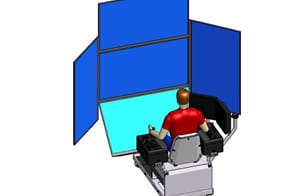Here at GlobalSim we’ve seen crane simulators evolve considerably since we entered the industry in the 1990’s. Much of this change has come from software enhancements – today’s simulators feature realistic graphics that so closely resemble the equipment and surroundings that it’s difficult to differentiate between a simulation and real life.
Another considerable change over the past several years has been the technology behind simulator Visual Channels (displays). Newer simulators feature flat-panel displays that are configured around the operator cabin. “Flat-panel displays are now the industry standard and have been for the past several years,” remarks Dan Olson, GlobalSim’s VP of Operations. “Generally, flat-panel displays are easier to maintain and less expensive than high-end projectors. We use flat-panel displays on about 90% of our systems and unlike the early flat-screens, today’s flat-panels have smaller bezels and excellent longevity.” Olson continues “There are only a few simulators where we don’t use flat-panel displays – the high-end dome systems located in some of the training centers still require projectors, but they’re only a few in the entire world.”
With flat-panel displays being used in the vast majority of simulators being produced (by GlobalSim and various other manufacturers) there are a few important items that clients and potential customers should be aware of:
The importance of image generators. An image generator is a computer with a high-end graphics card supplied by the simulator manufacturer. When the scenes are full of complicated equipment, loads, and vehicles, the image generator ensures the scene displays smoothly without jerks or flickers. High-end simulators update and refresh the images 60 times per second (60 Hz).
Alignment. When a simulator has more than one visual channel, the images must be aligned and color matched. This process can be somewhat complicated and can require special software or trained technical personnel to properly calibrate the system.
Field of View. The field of view refers to what the student operator sees. As desktop simulator with a 22” display gives a very small field of view. This could be similar to driving a car with a small window in the front and no side windows. The other extreme is a large dome system. A dome system with multiple projectors could have both a horizontal and vertical field of view that exceeds 180 degrees. Most simulators are somewhere in between. Note that the number of displays is irrelevant. One large display could have a larger field of view than six small displays. It depends on the placement. For example, a 40” display positioned 10 centimeters from the operator’s nose would be uncomfortable but might have a 135-degree horizontal field of view. But move the same display one meter away and the field of view could be reduced to 45 degrees. Properly integrating the above components is critical to creating an immersive training experience. GlobalSim is proud to provide professional training simulators that give students training value for the time spent in the simulator before the real equipment. To learn more about visual channels, contact us at +1-801-890-1940.
